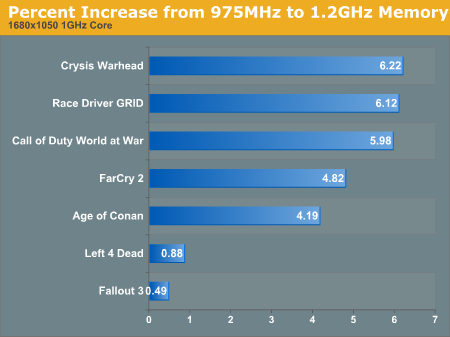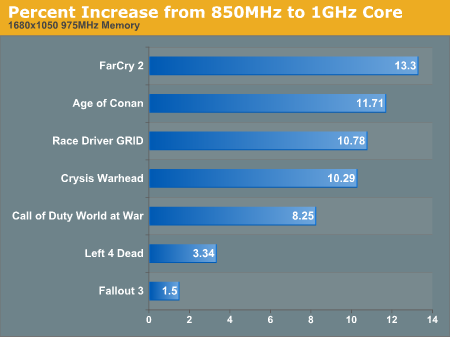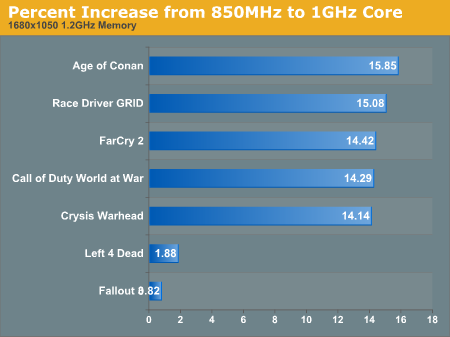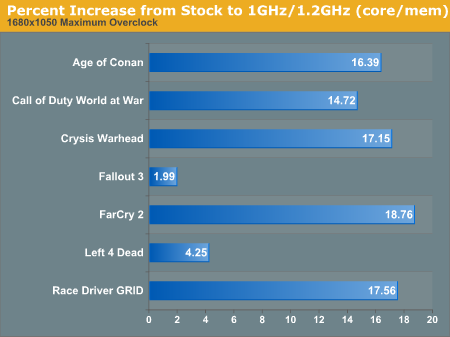Overclocking Extravaganza: Radeon HD 4890 To The Max
by Derek Wilson on April 29, 2009 12:01 AM EST- Posted in
- GPUs
Combined Memory and Core Overclocking: The Sweet Spot
In this round of tests, we combine our previous maximum overclocks. This is our compromise, in that we show the maximum potential of combined core and memory overclocking rather than effects of memory overclocking over each core clock speed we tested. While the latter option would be more complete, our tests do enough to show people what they need to know to find the sweet spot.
We theorized that with an extreme core clock speed that memory may have become a bottleneck to performance at some point. Despite the fact that increasing memory clock without increasing core clock didn't do much at all, we could see increased benefit beyond what one might expect based on our initial memory overclocking results.
Before we looked at varied memory clock with a stock core clock and varied core clock with a stock memory clock. Let's revisit both of those but also add in a twist. We will also look at percent increase in performance when overclocking memory with a 1GHz core clock and the percent increase in performance when overclocking the core with a 1.2GHz memory clock.

1680x1050 1920x1200 2560x1600

1680x1050 1920x1200 2560x1600

1680x1050 1920x1200 2560x1600

1680x1050 1920x1200 2560x1600
Note that in both cases we see a much bigger boost in performance. This means that while applications tend to be very heavily compute limited, at higher core clock speeds on AMD hardware memory bandwidth increasinly becomes a bottleneck. Now let's take a look at what we get when going from a completely stock part to a maximally overclocked part at 1GHz/1.2GHz (core/mem).

1680x1050 1920x1200 2560x1600
To get a basic idea of what's going on, here's an example of two programs. Remember that this isn't really real world and is just to illustrate the concept.
The first application is completely compute bound and the second is 50% compute bound and 50% memory bandwidth bound. Both tests generate 100 frames per second on a stock Radeon HD 4890. If we increase core clock speed 10%, the first application will generate 110 frames per second, while the second one would only generate 105. This is because we only see the 10% benefit while doing half of the work. If we look at only boosting memory performance 10%, the first program delivers only 100 fps while the second hits 105 again. Pushing both memory and core clock speed up 10% each gives us 110 frames per second from both applications. Basically.
Nothing is really that contrived or works like that, but the important thing to remember is that different applications can make varying use of different resources, and balancing those resources is important to ensuring the best performance in the most efficient package.
So, to find the sweet spot for your overclock, you will want to increase core clock speed as much as you can. Then bump up memory clock and see how high you can get it and remain stable. Use a real world application to test performance at each point and then use a binary search like algorithm to find the sweet spot in a short number of tests. And there you have it. We didn't do this for you, but what's better practice than a little hands on experience right? Besides, if gives readers the opportunity to compare notes in the comments on what the optimal memory clock for a 1GHz core clock on the 4890 would be. Have fun!










61 Comments
View All Comments
lopri - Thursday, April 30, 2009 - link
It's my impression that AMD cards are more responsive to clock frequencies, while NV cards are rather dependent on units/clusters. We've seen it from GTX 260 vs. GTX 280, as well as 8800 GTS vs. 8800 GTX. There were situations where GTX 280 / 8800 GTS can't come over the performance of their older brothers, even with massive overclocking. (and their clock generator don't generate clocks linearly)Just a thought.
Depeche - Wednesday, April 29, 2009 - link
BTW, great article but very long and time consuming xD to interesting. Keep up the great work!Depeche - Wednesday, April 29, 2009 - link
Doesn't AMD make the cards a whole different way then Nvidia? Don't they have like really high clocks and memory while Nvidias is a lot lower with higher of other parts?Also has Nvidia made a card that's simply overclocked like the 4870/4890?
SiliconDoc - Saturday, June 6, 2009 - link
ATI has lost TWO BILLION DOLLARS SELLING THEIR GPUs ! A BILLION A YEAR EASY - YET DEREK HAS THE UNMITIGATED GAUL TO SAY THIS:.
" In the meantime, NVIDIA's margins are much tighter on their larger GPUs and now their single GPU performance advantage has started to erode. It seems the wonders of the RV7xx series have yet to exhaust themselves. "
ROFLMAO !
THAT MIGHT MAKE SENSE IF ATI HADN'T COST AMD A BILLION PLUS A YEAR ON BARELY 2 BILLION IN SALES! ATI IS LOSING 33%.
THEY SELL $100's OF ATI CARD, THEY LOSE $33 !
---
THE TRUTH REALLY REALLY SUCKS , HUH RED ROOSTERS !
SiliconDoc - Saturday, June 6, 2009 - link
depeche: " Doesn't AMD make the cards a whole different way then Nvidia? Don't they have like really high clocks and memory while Nvidias is a lot lower with higher of other parts?Also has Nvidia made a card that's simply overclocked like the 4870/4890?
"
THE ARTICLE HERE " We absolutely must caution our readers once again that these are not off-the-shelf retail parts. These are parts sent directly to us from manufacturers and could very likely have a higher overclocking potential than retail parts. "
LOL - WELL THAT SHOULD ANSWER YOUR QUESTION !
cocka doodle dooooo ! cocka doodle doo ! red rooster rides again !
ValiumMm - Tuesday, May 5, 2009 - link
lol noooobkmmatney - Wednesday, April 29, 2009 - link
I had an NVidia Ti4200 that overclocked well - good enough to basically double the cards value. The original Radeon LE also overcloked well, and you could unlock extra pipes. I also still have an X800GTO2 that could be Bios flashed to an X850XT.nubie - Wednesday, April 29, 2009 - link
I am not sure I understand what you mean by "simply overclockable"Just add the coolbits registry value to the classic control panel and there are two simple sliders. It has been that way for years.
As far as the speeds you can reach, just take care that there is enough cooling and power (voltage bumps if need be).
I learned how to shade a resistor and take voltage measurements over at vr-zone, I think Shamino has a tutorial for it.
StevoLincolnite - Wednesday, April 29, 2009 - link
The most Overclockable card that I can remember from nVidia was the Geforce FX 5700LE it's stock core speed was 250mhz, I managed to crank my core speed on that card all the way to 640mhz on the stock Heatsink and fan, however thats not saying much as the 5700LE was basically a regular 5700 but with it's clockspeeds reduced to 5200 speeds, before that I had a Geforce 2 MX100 which was incredibly overclockable, and the TNT Vanta I had before it was as well, however I don't think I have seen a high-end part with that much overclocking margin.nubie - Wednesday, April 29, 2009 - link
If you are willing to raise the voltage you can get really good overclocks.I had a 7900GS up to 720mhz (from 450mhz) before it couldn't take it. Backing off to 708-700 made it stable, so I settled for 650 and it has been rock-solid for 3 years.
It all depends on the kind of cooling and power you can bring it.